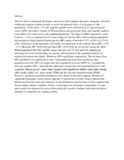The population structure of wild sorghum species in agro-ecological zones of Western Kenya

Date
2015Author
Shibairo, Solomon I
Mutitu, Eunice
Obukosia, Silas D
Ngugi, Eliud K
Magomere, Titus O
Language
enMetadata
Show full item recordAbstract
There is need to understand the genetic structure of wild sorghums that grow alongside cultivated traditional sorghum varieties in order to assess the potential effect of crop genes in wild populations. In this study, 175 wild sorghum samples were collected from 13 agroecological zones (AEZs) from three counties in Western Kenya and genotyped using microsattelite markers. Crop alleles were observed in wild sorghum populations. The range of allelic frequencies varied from low (˂0.4), to moderate (0.4-0.7) and to high (0.7) in the AEZs. Wild sorghum populations had moderate to high expected heterozygosity (HE) values of between 0.453 in LM1 to 0.715 in LM2. Differences in the magnitude of diversity was significant in the counties (Busia HE = 0.59 – 0.71; Homabay HE = 0.58-0.68 and Siaya HE = 0.45-0.59) but not distinct among the AEZs. Whole population FIS, FST and FIT values were low at 0.15, 0.16 and 0.29, respectively indicating low level of inbreeding, low genetic differentiation of the population and low to moderate deviation from Hardy–Weinberg (HW) equilibrium respectively. The deviation from HW equilibrium was significant in some wild populations from Siaya and Busia. Intra-population diversity (HS) was larger than inter-population diversity (DST) in 13 populations from the sampled AEZs, indicating the importance of gene flow between populations of wild sorghums. Heterozygosity values under mutation drift equilibrium (HEQ) varied under infinite allele model (IAM), two–phase model (TPM) and the step wise mutation model (SMM). However, significant population bottlenecks were absent in the wild sorghums. Presence of significant geographic county clusters and lack of significance on AEZ clusters indicate that human activities have had more influence on the distribution and diversity of wild sorghums than the prevailing climatic conditions. Efforts towards physical and genetic containment of crops genes need to be enhanced for successful ecologically sensitive confined field trials and future adoption of transgenics in cropping systems.
